Options and settings
In TimePunch different settings can be selected in the options. These are described in more detail in this chapter.
To access the options, open the "Options" dialog in the "Tools" menu.
UI Settings
On the first page, general TimePunch operating options can be selected. These are:
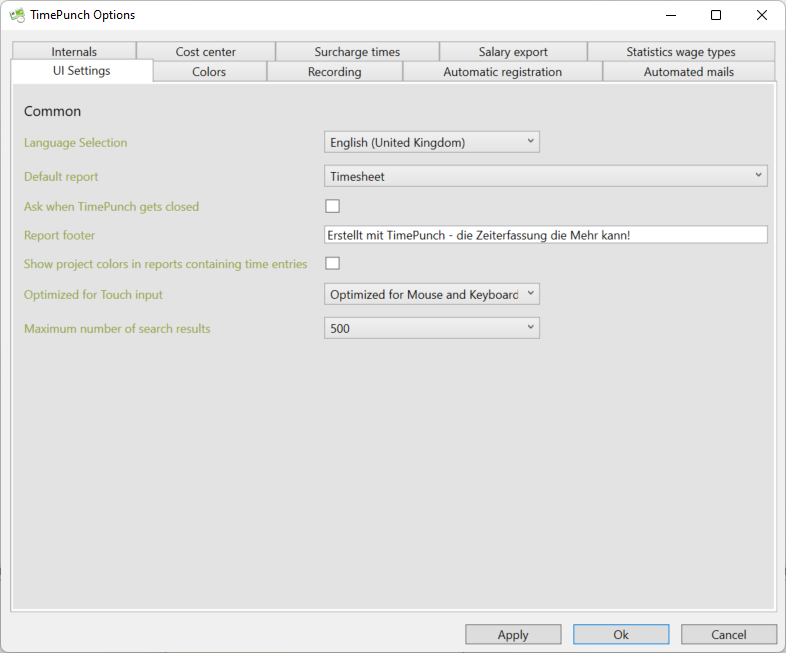
Language selection:
The display language, date and currency formatting can be selected in the language selection.
Default report:
The default report determines which report is to be printed if no report has been explicitly opened.
Ask when TimePunch gets closed:
This option opens a dialog when closing TimePunch in which the user must explicitly confirm closing TimePunch.
Report footer:
The text in the report footer is printed at the end of each report.
**
**
Optimized for:
The operation of TimePunch can be optimized for mouse, keyboard and touch input. When optimizing for Touch, the date and time selection in TimePunch Watcher and Studio changes.
Maximum number of search results:
In this selection list you can set how many search results are returned by the integrated searches. This concerns e.g. the search for employees, projects and customers.
Color selection
The colour selection is individually adjustable for the user. The following options are possible:
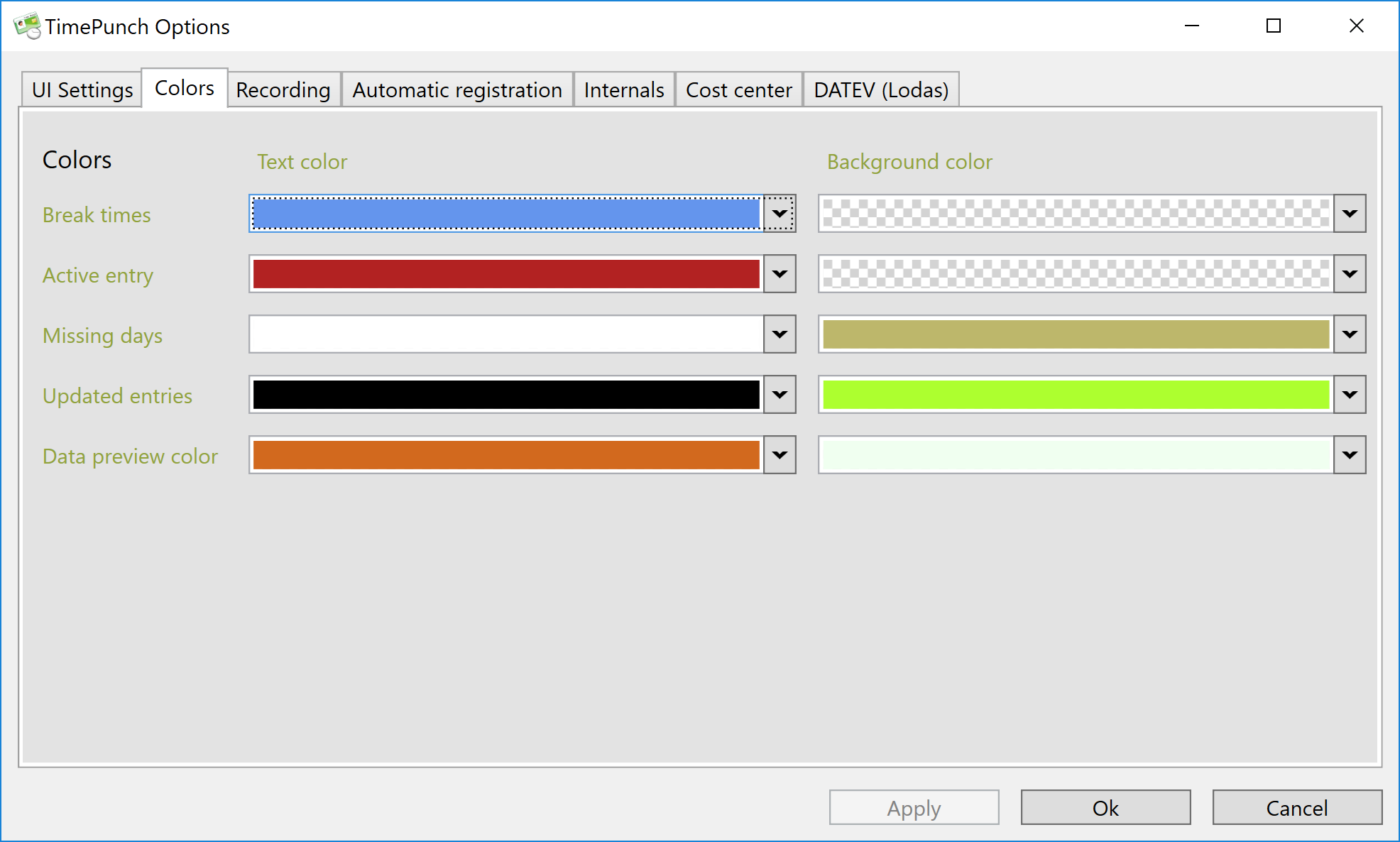
Break times:
This color determines how the break times between working time entries are displayed.
Active time entry:
This color determines how the active time entries are displayed. An active entry is the current recording of working time.
Missing days:
This color determines how missing days are highlighted. The highlighting of the missing days must be activated in the "Display" menu.
**
**
Updated entries:
This color determines how manually changed time entries are highlighted. The highlighting of the changed entries must be activated in the "Display" menu.
Data preview color:
This color determines how the automatically pre-calculated working times are highlighted in color. The advance calculation of the time entries is to be activated by an administrator in the menu "Display".
Recording at TimePunch PRO
This register determines how time entries should be recorded by the TimePunch Watcher/Studio.

Recording mode:
Full time recording with pause mode
In this mode, the user is free to change or restart the project, stop or pause the recording.
Simplified start/stop time recording
With the simplified start and stop time recording, the user can change or restart the project and stop recording. A pause is implemented by stopping and restarting time recording.
Automatic time recording and project selection only
In the simplest mode, the user can only select a new project and start it. A manual pause can no longer be inserted. However, automatic pauses are still recorded (e. g. if the screen saver is activated). This setting also prevents inadvertent recording gaps by stopping the time recording.
Start time recording at the start of the watcher and stop it automatically when quitting the watcher:
If this setting is set, time recording starts immediately after logging on to the PC. In this case, logging starts with the project of the previous day. In addition, this point causes the logging to stop as soon as the TimePunch Watcher ends.
Define start project
In TimePunch the respective start project can be defined in the TimePunch Watcher. The start project determines with which project/activity the first recording is to be started.
Remind me of project update
This option allows TimePunch to remind you to check the time recording. Especially if projects / activities are changed frequently during the day, it can be useful that TimePunch reminds the user to check his own activities by displaying the window.
When locking Windows
This setting can be used to define how TimePunch behaves when locking Windows. The following selection is available as an option:
Pause time recording
TimePunch goes directly into pause mode after locking Windows and continues to run automatically as soon as the PC is unlocked.
Ignore 5 to 30 minutes absence
With this option, time recording continues until the set time is reached. If the PC is still locked after this time, then the complete time from locking the PC until logging on again is calculated as a pause.
Don’t pause time recording at all
Even if the PC is locked, time recording continues to run unless you switch to pause mode manually.
But no matter which setting has been selected: As soon as the PC is locked for more than 6 hours, the time entry is cancelled. The end date is the time of blocking.
Note: The screen saver also locks the PC. With this setting, an activated screen saver can be automatically entered as a pause time as soon as the specified time period is exceeded.
**
**
recording accuracy
This setting determines the rounding of the start and end times for time recording. By default, counting by the minute is preset. Particularly in the case of craft businesses, however, it can also make sense from the point of view of accounting to set the rounding accuracy to 5 minutes or higher.
GPS tracking
Currently the location determination is only possible for the online version of TimePunch. But here you can set how the GPS data should be plotted. The following options are available.
Never
TimePunch will not record GPS data. Not even if the setting in the smartphone would allow it.
Ask user
GPS data recording is optional in TimePunch. If the setting is allowed in the smartphone, there will be no request to the employee. In case of demand, the employee can allow or prohibit it.
Mandatory
In this mode the recording of GPS data is mandatory. If the employee refuses the recording by deactivating the option on the smartphone, he can neither start nor stop the time recording.
Recording at TimePunch TEN
This register determines how time entries are to be recorded by the TimePunch TEN.

Start with the following project
The working time project defines the project that is used for regular time recording. The standard for this project is “working-time”.
Project to use for a short business trip
The short business trip project defines the project that is used for short business trips. Additionally, it is possible in TimePunch to define several tasks that can be used to distinct the short business trips, e.g. customer meeting or public authority.
Recording precision and waiting period
The recording precision defines the rounding that is used for the time recording. The standard is exact to the minute. The waiting period determines the period up to which a rounding is applied in favor of the employee.
Example: A recording accuracy of 10 minutes is selected. The waiting period is 3 minutes.
If the employee arrives too late, e. g. 2 minutes after 8:00 am, the employee is logged on at 8:00 am. If it comes later than the waiting period, time recording does not start until the next rounding, i.e. at 8:10 o' clock.
Length of the transponder id
Depending on the transponder that is used, the key length may vary. The key length for our standard transponder, e.g. is 4 digits. Please contact our support if you are not sure what key length to use.
Connection
In this tab you can specify how often TimePunch checks for updates.
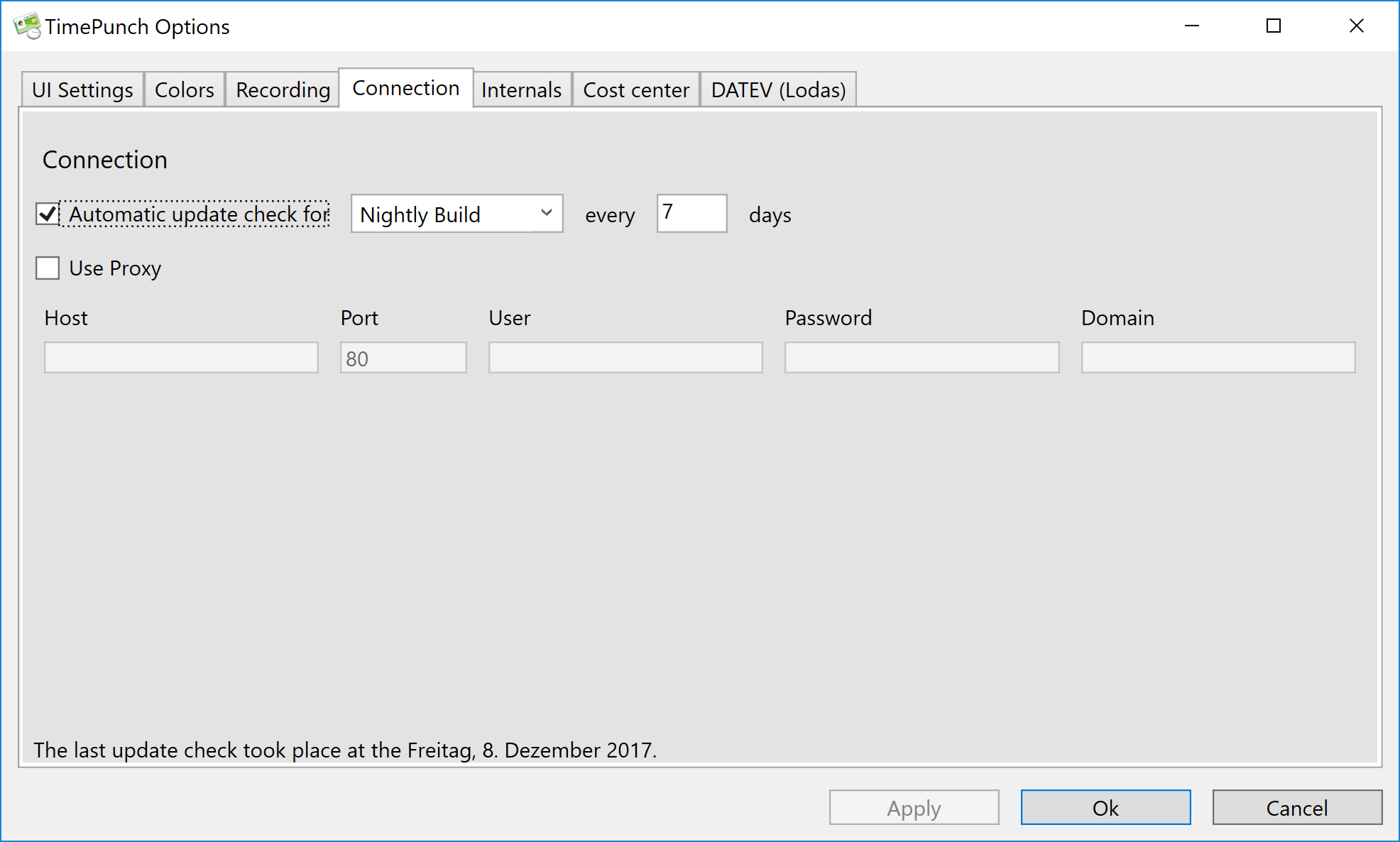
If a proxy is necessary, the proxy server can be entered here.
Automatic registration
This page determines whether and how new employees can connect to TimePunch.
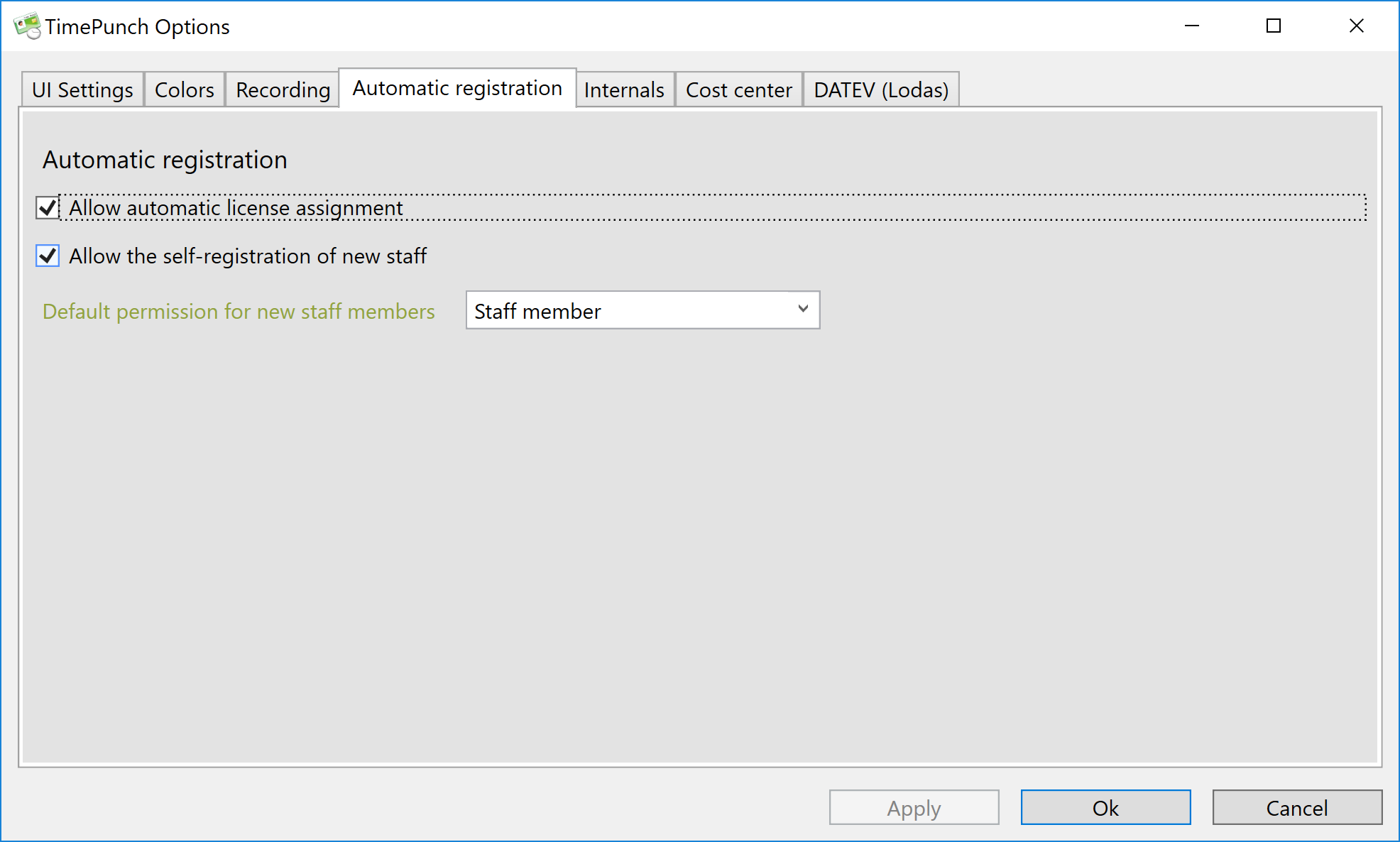
Allow automatic license assignment
If this option is activated, free licenses are automatically assigned to the employees. This may be practical, but it is not always desired.
Example: 5 TimePunch PRO licenses are available. Currently, only two licenses are assigned to the personnel office. If another employee tries to connect to TimePunch PRO (e. g., who has only one registration license), a new license is automatically assigned to him/her if this selection box is active.
This behaviour can be quite problematic in larger companies and can therefore be eliminated here.
Allow self-registration of new employees
If this option is active then the logon dialog shows the possibility to switch to registration. If an employee cannot be found in the list of possible employees, he or she can create and register himself or herself in TimePunch.
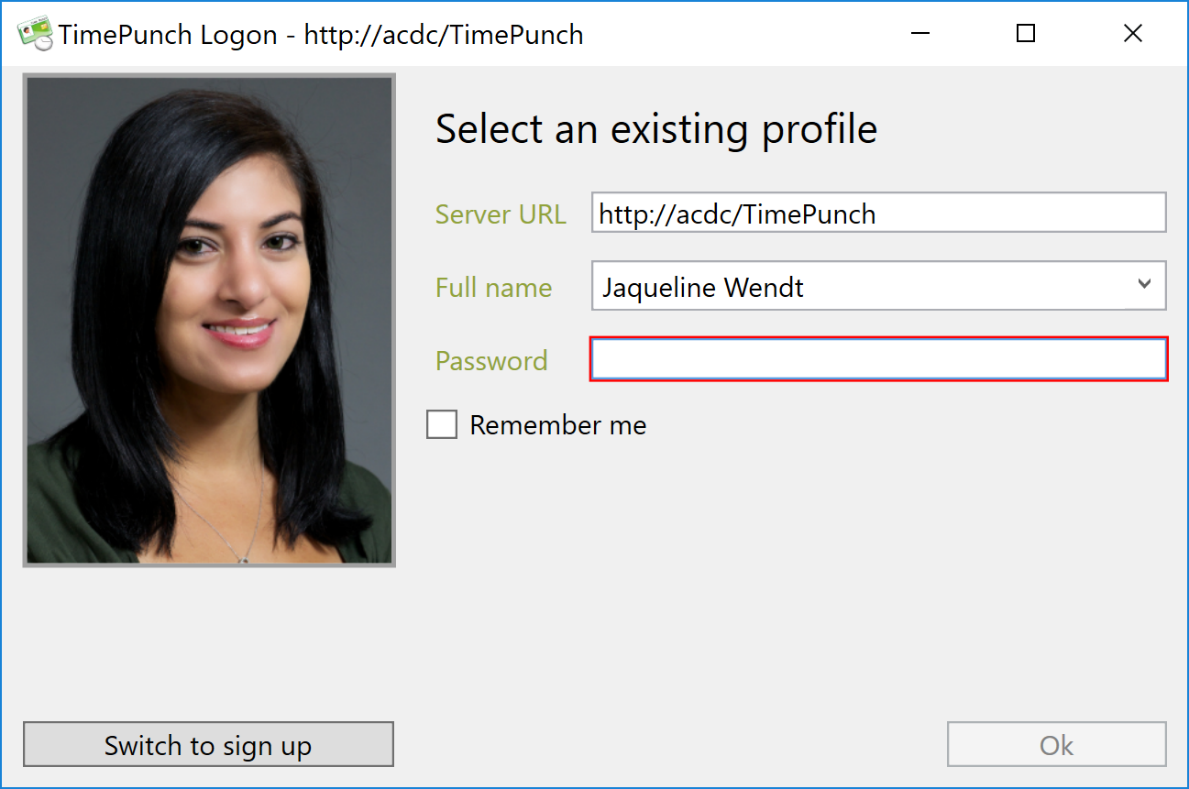
This option can also lead to undesired behavior in larger companies, if employees can register themselves independently even though they may have already been created by the HR department.
By deactivating the option, the button "Switch to sign up" is no longer available. In this case, you can only create new employees in the HR department in the master data.
Default permission for new staff members
This selection box determines which rights new employees receive when they create themselves in the system via self-registration.
Internals
On this page, settings are made for the calculation logic used internally by TimePunch. Only administrators can make changes on this page.
Leave pay for wage workers
This setting defines how vacation pay, sick pay or continued pay on public holidays should be calculated.
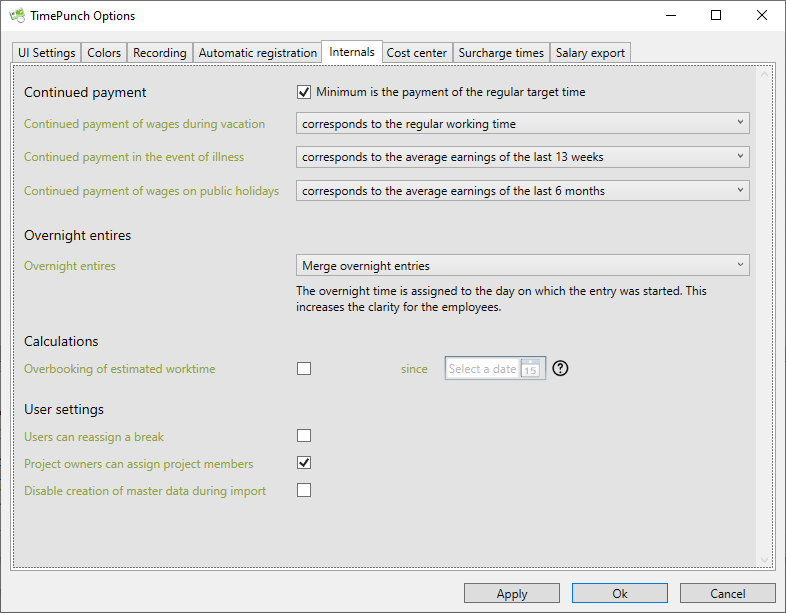
- Corresponds to target hours
If this setting is selected, the wage is credited to the employee as leave remuneration, which is also reflected in the planned working time of the working time model.
This is a simplified calculation which was the standard until version 2.8 of TimePunch.
- Corresponds to the average earnings of the last 13 weeks
This attitude is in line with the current legal situation in Germany. The holiday pay is calculated from the average earnings of the last 13 weeks.
See: https://www.gesetze-im-internet.de/burlg/__11.Html
- Corresponds to the average earnings of the last 6 months
As another option, the average salary continuation can also be calculated according to the earnings of the last 6 months.
Hint:
If you want to change the calculation logic, complete all old months (Tools / Month-End Closing). Only then can the calculation logic be changed without fear of a change in overtime.
If the calculation logic is changed without a previous month-end closing, this can possibly lead to a recalculation of the working time and a change in the overtime account.
Minimum is the payment of the regular target time.
This option specifies that continued pay cannot fall below the regular target time. This may be the case, for example, if an employee has been sick (unpaid) for an extended period or has taken an unpaid sabbatical.
Overnight entries
TimePunch has two different models for displaying overnight entries.

• Split overnight entries
In this mode, overnight entries are distributed over the two working days. If an entry starts, for example, at 10 p.m. to 6 a.m., then 2 hours are booked on the first day and 6 hours on the second day.
• Merge overnight entries
In the standard setting, overnight stay entries are assigned to the day on which they were started. This setting increases clarity for employees.
Overbooking the estimated worktime
This feature enables you to overbook the planned working time of a working day with leave, illness or other absence types. This may be necessary if the planned working time stored does not correspond to the employee's actual working time.
**
**
User Settings
The following employee-specific settings can be set.

Employees can take a break again
If this selection box is set, employees without special editing rights can also assign a break time entry to a project. Start and end of the pause cannot be changed by employees without special editing rights.
Project managers can assign employees
This setting allows project managers to change the assignment of employees to the project, i. e. assign an employee to the project. If this selection box is not set, then only employees with administration rights can authorize the employees to access the projects.
Disable creation of master data during import
Activating this option means that when importing time data from CSV format, all projects and activities must already exist in TimePunch. If this is not the case, the import is terminated with an error message.
By default, this option is disabled, i.e. the referenced projects/activities from the CSV file are automatically generated in TimePunch.
Project Settings
The following project-specific settings can be set.
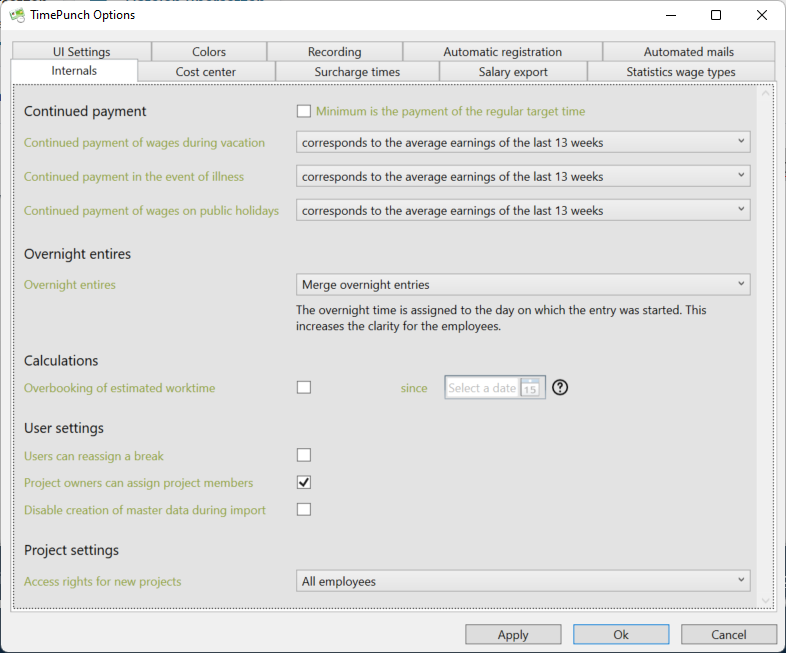
- - Access rights for new projects
This setting defines with which access rights newly created projects are created.
Surcharge relevant times
In this dialog, you can define the periods in which separate wage types can be used for wage data export.
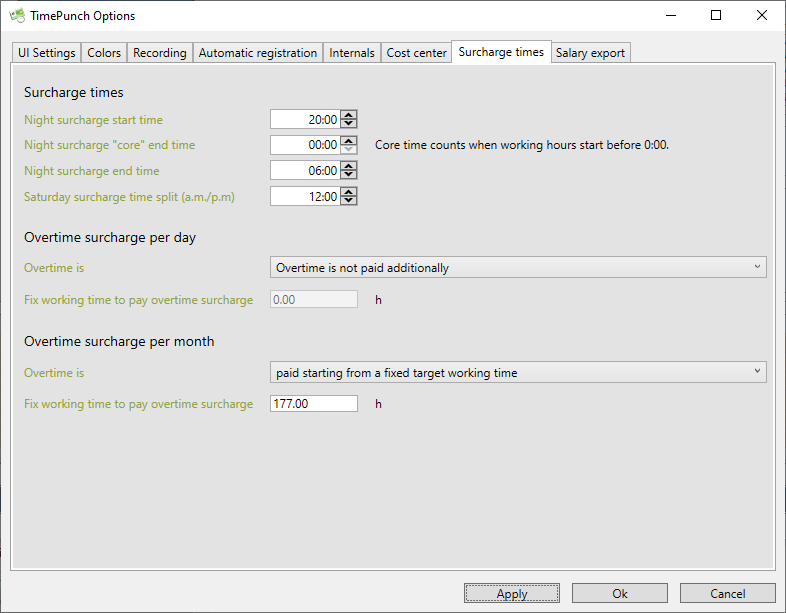
Night surcharge
The night surcharge is optional in TimePunch. For this reason, the settings set here are only used if a corresponding wage type has been set for the night bonus in DATEV Export.
Night surcharge start time
The time set as the night surcharge start time is used to calculate a possible night surcharge.
Night surcharge “core” end time
The core time for the night surcharge is the time from 0:00 a. m. to the specified time. During this period, an increased night surcharge may be paid.
Night surcharge end time
The time set as the end of night surcharge is used to define the end of the night surcharge.
Saturday surcharge Split (morning / afternoon gas)
Different bonuses can be claimed for Saturday mornings and afternoons. The splitter only specifies the time up to which the morning bonus starts and the time from which the afternoon bonus starts.
Overtime surcharge
Overtime surcharge can be calculated on a daily or monthly basis.
In both cases, it is possible to specify whether an overtime bonus is paid from a fixed working time or according to the employee's individual target working time.
Example per day: A 37.5-hour week is defined for the employee. This means that the target time per day is 7.5 hours. An overtime bonus is fixed as of 8 hours. This means that the employee only receives an overtime bonus if his real working time exceeds 8 hours.
Example per month: The employee has a real working time of 170 hours. From 160 hours onwards, an overtime bonus is paid. He will therefore be paid 10 hrs separately.
Hint:
For the overtime bonus to be paid, the overtime (special bonus) must be activated in the wage data.
Salary export
In this dialog box, you can specify which system is used to export the wage data and to which wage types the posted times should be exported.
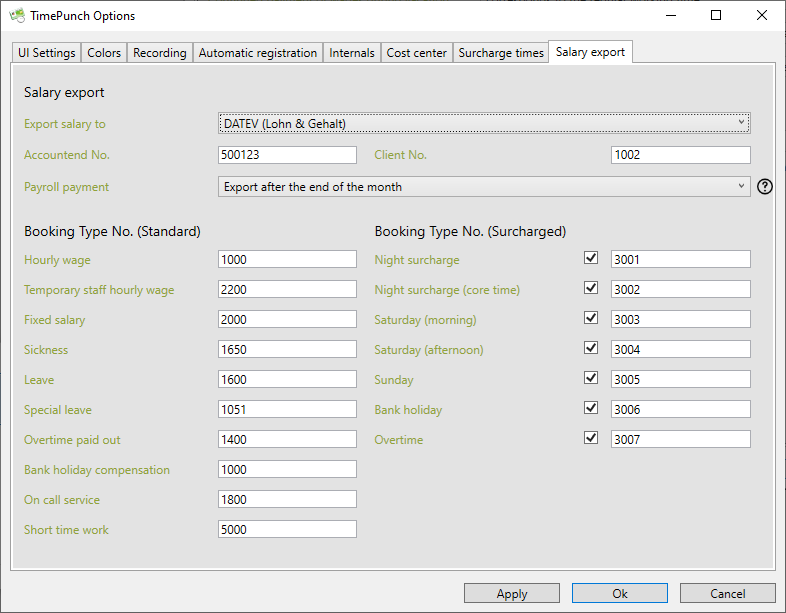
If special bonuses are to be paid, for example, a night bonus, the check mark for night bonus must be set and a corresponding wage type must be entered.
Note:
The wage types can also be stored in the employee profile per employee. The employee-specific settings then overwrite the global settings from the Extras / Options dialog box.
Statistic wage types
Since holidays, sickness and the working time account are managed in TimePunch and not in the payroll software, statistical data can be exported to the payroll software in addition to the regular wage data.
This statistical data has no influence on the salary calculation, but it can be printed by the payroll software on the salary statement for the employee.
The following statistics wage types exist:
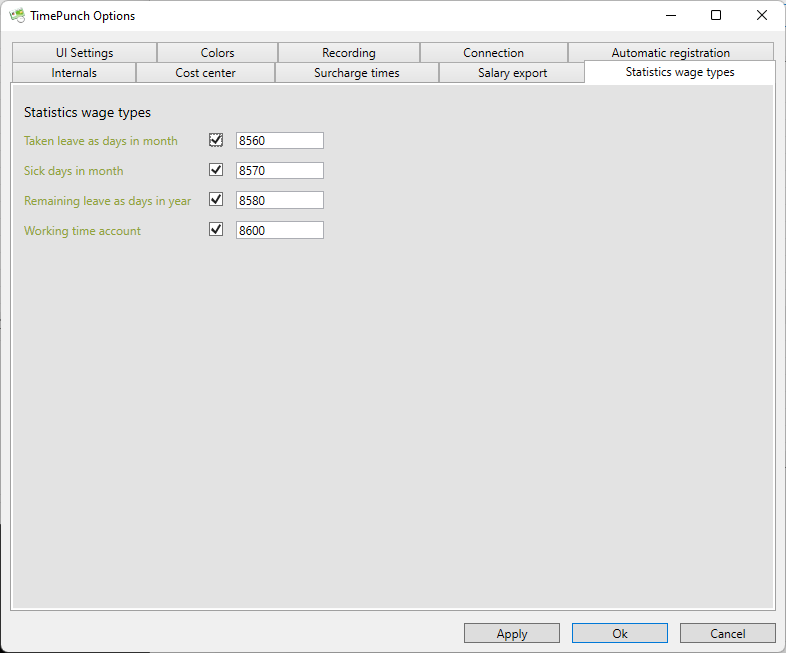
If the statistics wage type is ticked, it is exported with the monthly data export.